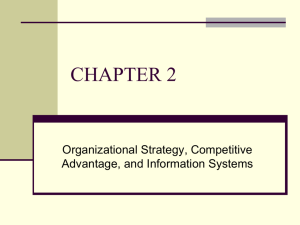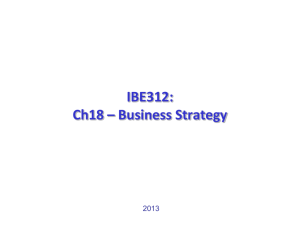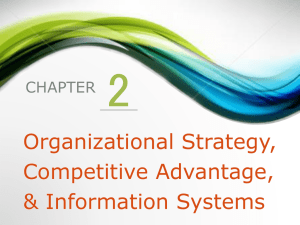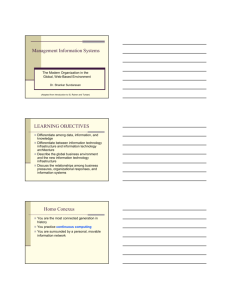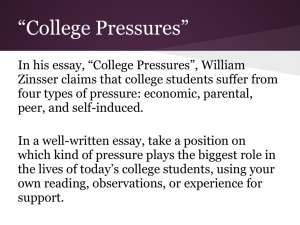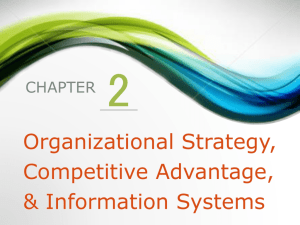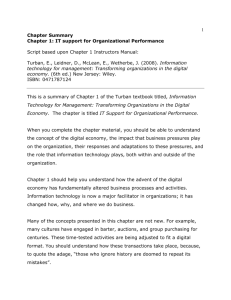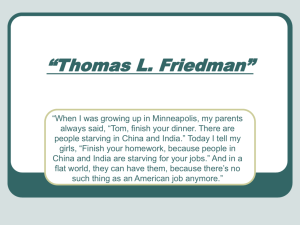Information System
advertisement
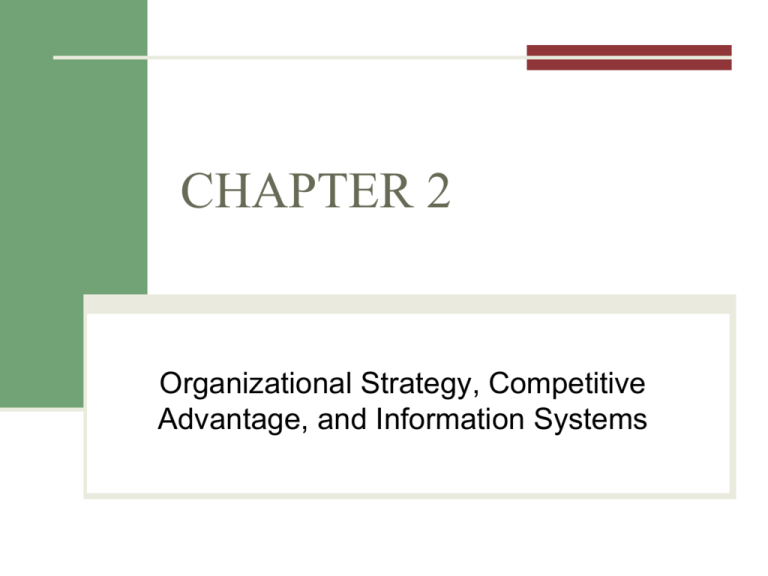
CHAPTER 2 Organizational Strategy, Competitive Advantage, and Information Systems Review/Announcements What is the difference between IS and IT? • Information Technology – any computer based tool that people use to work with the IS (device) • Information System – collects, processes, stores, analyzes and disseminates information (applications/software/system) Questions/Comments Chapter Opening Case Respond to business pressures Align IT strategy with company strategy Media Bakery Competitive Advantage Competitive advantage is an advantage over competitors in some measure such as: Can be, using technology, achieved through: 2.1 Business Processes Business Process Accounting: Managing accounts payable Finance: Producing business forecasts Marketing: Managing customers Operations: Processing inventory MIS: Applying disaster recovery procedures Cross-Functional Business Processes 2.1 Business Processes – Student Registration (offline) Schedule Appt. w/ Advisor Discuss Degree Plan Select Courses from Catalog Update Degree Plan Update Course Roster 2.1.1 How do you ensure business process excellence? Business Process Reengineering Business Process Management 2.1 BPR – Student Registration BPM– SAP Solution Manager Alert Graphics Single Monitoring Alerts Alert overview Monitoring Session 2.2 Business Pressures, Organizational Responses, and IT Support Business Pressures 1. 2. 3. 2.2.1 Market Pressures The Global Economy and Strong Competition The Changing Nature of the Workforce Powerful Customers (Source: Studio Frank/Image Source L imited) The Stages of Globalization (From Thomas Friedman in The World is Flat) 3.0 2.0 2000 - Now 1800 - 2000 1.0 1492 - 1800 © WAVEBREAKMEDIA/Age Fotostock America, Inc. Thomas Friedman’s Ten Flatteners Fall of the Berlin Wall Netscape goes public Development of work-flow software Uploading Outsourcing Offshoring Supply Chaining Insourcing Informing The Steroids Flattener: Uploading PASSSIVE PARTICIPANTS ACTIVE/ENGAGED USERS WEB 2.0 OPEN SOURCE Flattener: Supply Chaining Flattener: Insourcing Flatteners: The Steroids Flatteners: The Steroids (continued) Instant messaging and file sharing Voice over Internet Protocol Flatteners: The Steroids (continued) Videoconferencing (Telepresence) Wireless Technologies Source: PRNews Foto/Polycom, Inc./NewsCom (Source: Marianna Day Massey/Zuma Press.) 2.2.1 Flatteners Exercise Access www.go4customer.com. What does this company do and where is it located? Who are its customers? Which of Friedman’s flatteners does this company fit? 2.2.2 Technology Pressures What do you think are the most prevalent technology pressures? Technological Innovation and Obsolescence Obsolescence: Electronic Numerical Integrator and Computer Innovation: PC/Laptop Information Overload Social Media Overload Source: © Maria R.T. Deseo/PhotoEdit) How many indexed web pages exist? http://www.internetsociety.org/map/global-internet-report/ http://www.worldwidewebsize.com/ 2.2.3 Societal/Political/Legal Pressures 1. 2. 3. 4. Social Responsibility See CBS video on disposal of e-waste Green IT Corporate Carbon Mgmt Social Responsibility: Digital Divide One Laptop per Child initiative Government Regulations Regulations are changing corporate technology polices Examples of Regulations: • Sarbanes-Oxley Act (Enron) • Health Insurance Portability and Accountability Act (HIPAA) Responses to Business Pressures 1. Strategic Systems 2. Customer Focus 3. Make-to-Order and mass customization 4. E-Business and E-Commerce 2.3 Competitive Advantage and Strategic Information Systems How do we analyze competitiveness? Porter’s Competitive Forces Model Porter’s Competitive Forces Model The rivalry among firms in an industry is high when there is fierce competition and low when there is not. Porter’s Competitive Forces Model Threat of entry of new competitors is high when it is easy to enter a market and low when significant barriers to entry exist. A barrier to entry is a product or service feature that customers expect from organizations in a certain industry. Does technology and systems increase/decrease threat of entry? Porter’s Competitive Forces Model The bargaining power of suppliers is high when buyers have few choices and low when buyers have many choices. Internet impact is mixed. Buyers can find alternative suppliers and compare prices more easily, reducing power of suppliers. Porter’s Competitive Forces Model The bargaining power of customers/buyers is high when buyers have many choices and low when buyers have few choices. Does the Internet increase or decrease power of buyers? Why? What about switching costs? Porter’s Competitive Forces Model The threat of substitute products or services is high when there are many substitutes for an organization’s products or services and low where there are few substitutes. Which type of industries are at risk? Information-based industries are in the greatest danger Strategies countering 5 Competitive Forces (creating advantage) Cost Leadership Differentiation Innovation Operational Effectiveness Customer-orientation Applying the Value Chain - Costco What is Costco’s competitive strategy? Who are Costco’s major competitors (i.e. rival)? How would Costco’s information systems contribute to Costco’s competitive strategy, given the nature of its business? 2.4 Business – Information Technology Alignment © Toh Kheng Ho/Age Fotostock America,Inc Applying to all majors Business Processes CHAPTER REVIEW What is an example of a business process used at UNCW? CHAPTER REVIEW What are the differences between: BPM BPR CHAPTER REVIEW What are 3 business pressures discussed today? 1. 2. 3. CHAPTER REVIEW Strategies for countering competitive forces using technology:
